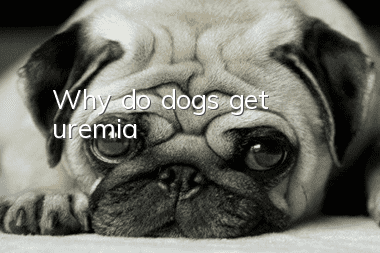Why do dogs get uremia?

Causes of uremia in dogs
1. Absorption of intestinal toxic substances, such as phenol, tyramine, phenylethylenediamine, etc., are absorbed from the intestine After entering the blood, due to kidney failure and reduced liver detoxification function, the poison accumulates in the blood and causes poisoning.
2. Due to renal failure, urea enters the intestinal cavity and is decomposed by intestinal bacteria into ammonia and ammonium salts, which are then absorbed into the blood, causing symptoms of nervous system poisoning.
3. The accumulation of toxic products from the decomposition of certain proteins, such as guanidine compounds, can inhibit the activity of certain enzymes (lactate dehydrogenase, ATPase, etc.) in the body, causing convulsions in dogs, and can also induce convulsions in dogs. Gastroenteritis, pericarditis, bleeding and reduced immune function.
4. Acidosis occurs due to impairment of excretion of acidic metabolites, causing changes in respiratory and cardiovascular activities and coma.
Treatment of uremia in dogs
1. Administer sodium bicarbonate according to the degree of acidosis, and choose calcium-free infusions to adjust hyperkalemia. Supplement a large amount of amino acids, high-energy, vitamin preparations, etc. to improve hyperzotaemia. For dogs with prerenal uremia, administer furosemide 2 to 4 mg/kg body weight every 8 to 12 hours, or diuretic acid 1 to 2 mg/kg body weight in 2 divided doses. When neurological symptoms occur, administer chlorpromazine 10 to 20 mg/kg body weight or phenobarbital 2 to 5 mg/kg body weight orally three times a day.
2. When the blood urea nitrogen is 100 mg/100 ml, the serum creatinine is 10 mg/100 ml, and the serum potassium is 6 mmol/l, peritoneal dialysis can be performed. Dialysate is a calcium-free fluid. Intermittent peritoneal perfusion is relatively simple. For dogs with severe water retention, hypertonic sugar perfusion solution can be used. If the symptoms relapse after repeated perfusion, it indicates that the kidneys have completely lost their function. Prognosis is poor.
3. Cut and disinfect the abdominal wall, puncture it with an ascitic trocar needle, and insert a multi-hole cannula. Remove the cannula and leave the cannula in place. After the perfusate is warmed, 50 to 150 ml/kg is injected each time. After staying for 40 minutes, the fluid is drained naturally and repeated 2 to 3 times. The perfusate is usually sodium lactate compound preparation.
4. When pulmonary edema is severe, use a compound preparation of glucose and sodium lactate with high osmotic pressure. Since the perfusate does not contain potassium chloride, for dogs with hypokalemia, 4 ml of potassium chloride (4 mmol/L) should be added to each liter of perfusate.
- Dog’s anal gland odor, please note that this is a sign of your dog’s health!
- How to make your dog like to eat dog food Four ways to make your dog fall in love with dog food
- How to protect your dog’s food? Teach you tips on training your dog
- Why do dogs defecate everywhere? How can dogs stop defecating everywhere?
- What should I do if my dog has lupus? Immune system diseases should not be underestimated
- If your dog's hair is cut and the skin is cut, the flesh is exposed. If the dog's hair is accidentally cut and the skin is cut, it must be disinfected immediately.
- Do dogs need deworming in summer? What should you pay attention to when raising dogs in summer?
- What to do if your dog has indigestion? Dog indigestion is no small matter!
- What should you pay attention to when vaccinating your dog? What should you pay attention to when vaccinating your dog?
- Symptoms of Rheumatism in Dogs What conditions can cause rheumatism in dogs?



